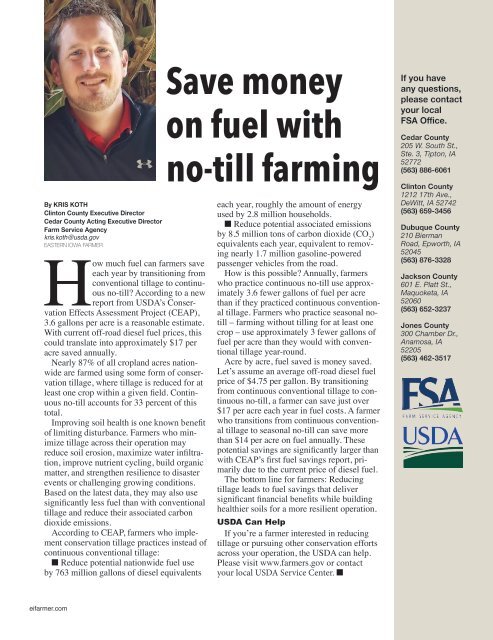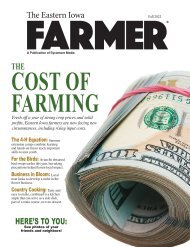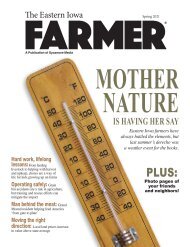EasternIowaFarmer_Fall2023
You also want an ePaper? Increase the reach of your titles
YUMPU automatically turns print PDFs into web optimized ePapers that Google loves.
By KRIS KOTH<br />
Clinton County Executive Director<br />
Cedar County Acting Executive Director<br />
Farm Service Agency<br />
kris.koth@usda.gov<br />
EASTERN IOWA FARMER<br />
How much fuel can farmers save<br />
each year by transitioning from<br />
conventional tillage to continuous<br />
no-till? According to a new<br />
report from USDA’s Conservation<br />
Effects Assessment Project (CEAP),<br />
3.6 gallons per acre is a reasonable estimate.<br />
With current off-road diesel fuel prices, this<br />
could translate into approximately $17 per<br />
acre saved annually.<br />
Nearly 87% of all cropland acres nationwide<br />
are farmed using some form of conservation<br />
tillage, where tillage is reduced for at<br />
least one crop within a given field. Continuous<br />
no-till accounts for 33 percent of this<br />
total.<br />
Improving soil health is one known benefit<br />
of limiting disturbance. Farmers who minimize<br />
tillage across their operation may<br />
reduce soil erosion, maximize water infiltration,<br />
improve nutrient cycling, build organic<br />
matter, and strengthen resilience to disaster<br />
events or challenging growing conditions.<br />
Based on the latest data, they may also use<br />
significantly less fuel than with conventional<br />
tillage and reduce their associated carbon<br />
dioxide emissions.<br />
According to CEAP, farmers who implement<br />
conservation tillage practices instead of<br />
continuous conventional tillage:<br />
n Reduce potential nationwide fuel use<br />
by 763 million gallons of diesel equivalents<br />
Save money<br />
on fuel with<br />
no-till farming<br />
each year, roughly the amount of energy<br />
used by 2.8 million households.<br />
n Reduce potential associated emissions<br />
by 8.5 million tons of carbon dioxide (CO 2<br />
)<br />
equivalents each year, equivalent to removing<br />
nearly 1.7 million gasoline-powered<br />
passenger vehicles from the road.<br />
How is this possible? Annually, farmers<br />
who practice continuous no-till use approximately<br />
3.6 fewer gallons of fuel per acre<br />
than if they practiced continuous conventional<br />
tillage. Farmers who practice seasonal notill<br />
– farming without tilling for at least one<br />
crop – use approximately 3 fewer gallons of<br />
fuel per acre than they would with conventional<br />
tillage year-round.<br />
Acre by acre, fuel saved is money saved.<br />
Let’s assume an average off-road diesel fuel<br />
price of $4.75 per gallon. By transitioning<br />
from continuous conventional tillage to continuous<br />
no-till, a farmer can save just over<br />
$17 per acre each year in fuel costs. A farmer<br />
who transitions from continuous conventional<br />
tillage to seasonal no-till can save more<br />
than $14 per acre on fuel annually. These<br />
potential savings are significantly larger than<br />
with CEAP’s first fuel savings report, primarily<br />
due to the current price of diesel fuel.<br />
The bottom line for farmers: Reducing<br />
tillage leads to fuel savings that deliver<br />
significant financial benefits while building<br />
healthier soils for a more resilient operation.<br />
USDA Can Help<br />
If you’re a farmer interested in reducing<br />
tillage or pursuing other conservation efforts<br />
across your operation, the USDA can help.<br />
Please visit www.farmers.gov or contact<br />
your local USDA Service Center. n<br />
If you have<br />
any questions,<br />
please contact<br />
your local<br />
FSA Office.<br />
Cedar County<br />
205 W. South St.,<br />
Ste. 3, Tipton, IA<br />
52772<br />
(563) 886-6061<br />
Clinton County<br />
1212 17th Ave.,<br />
DeWitt, IA 52742<br />
(563) 659-3456<br />
Dubuque County<br />
210 Bierman<br />
Road, Epworth, IA<br />
52045<br />
(563) 876-3328<br />
Jackson County<br />
601 E. Platt St.,<br />
Maquoketa, IA<br />
52060<br />
(563) 652-3237<br />
Jones County<br />
300 Chamber Dr.,<br />
Anamosa, IA<br />
52205<br />
(563) 462-3517<br />
eifarmer.com
















